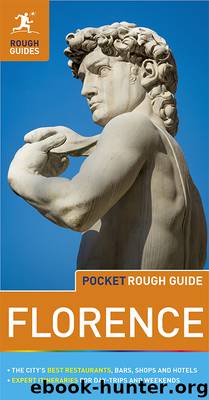Pocket Rough Guide Florence by Rough Guides

Author:Rough Guides
Language: eng
Format: epub
Publisher: Rough Guides
Published: 2016-02-01T05:00:00+00:00
zoom left
zoom right
Santa Croce
Santa Croce
Piazza Santa Croce santacroceopera.it.Mon–Sat 9.30am–5.30pm, Sun 2–5.30pm.€6, or €8.50 combined ticket with Casa Buonarroti.MAP
The church of Santa Croce is the Franciscans’ principal church in Florence and is said to have been founded by St Francis himself. In truth it was probably begun seventy or so years after Francis’s death, in 1294, possibly by the architect of the Duomo, Arnolfo di Cambio. Ironically, it was the city’s richest families who funded the construction of the church: plutocrats such as the Bardi, Peruzzi and Baroncelli sponsored the extraordinary fresco cycles that were lavished on the chapels over the years, particularly during the fourteenth century, when artists of the stature of Giotto and the Gaddi family worked here. And Santa Croce has long served as the national pantheon: it contains monuments to more than 270 illustrious Italians, including Michelangelo, Galileo, Machiavelli and Dante (though the last is not buried here).
On your way to the frescoed chapels be sure to take a look at Donatello’s gilded stone relief of the Annunciation (against the right-hand wall) and Bernardo Rossellino’s nearby tomb of Leonardo Bruni, chancellor of the Republic, humanist scholar and author of the first history of the city. (His successor as chancellor, Carlo Marsuppini, is commemorated by a splendid tomb in the opposite aisle, carved by Desiderio da Settignano.) The Cappella Castellani, at the end of the south aisle, was strikingly frescoed by Agnolo Gaddi and his pupils, while the adjoining Cappella Baroncelli was decorated by Agnolo’s father, Taddeo, a long-time assistant to Giotto.
Both the Cappella Peruzzi and the Cappella Bardi – the two chapels on the right of the chancel – are covered with frescoes by Giotto, with some assistance in the latter. Their deterioration was partly caused by Giotto’s having painted some of the pictures onto dry plaster, but the vandalism of later generations was far more destructive. Scenes from the lives of St John the Evangelist and St John the Baptist fill the Peruzzi chapel, while a better-preserved cycle of the life of St Francis fills the Bardi. Despite the areas of paint destroyed when a tomb was attached to the wall, the Funeral of St Francis is still a composition of extraordinary impact, the grief-stricken mourners suggesting an affinity with the lamentation over the body of Christ – one of them even probes the wound in Francis’s side, echoing the gesture of Doubting Thomas.
From the right transept a corridor leads to the Cappella Medici, which contains Bronzino’s huge Descent of Christ into Limbo and an altarpiece by Andrea and Giovanni della Robbia. Adjoining the corridor, the beautifully panelled sacristy is home to Cimabue’s great Crucifix, which was half-destroyed in the 1966 flood and has become in effect the emblem of that disaster.
On the other side of the church there’s a second Cappella Bardi, which houses a wooden crucifix by Donatello, supposedly criticized by Brunelleschi as resembling a “peasant on the Cross”.
The door in the right aisle leads through into the church’s Primo Chiostro (First Cloister), site
Download
This site does not store any files on its server. We only index and link to content provided by other sites. Please contact the content providers to delete copyright contents if any and email us, we'll remove relevant links or contents immediately.
Annapurna by Maurice Herzog(3445)
Liar's Poker by Michael Lewis(3411)
A Forest Journey by John Perlin(3042)
Atlas Obscura by Joshua Foer(2925)
The Ogre by Doug Scott(2656)
Cuba by Lonely Planet(2599)
Photographic Guide to the Birds of Indonesia by Strange Morten;(2506)
The Splendid and the Vile by Erik Larson(2406)
Tokyo by Rob Goss(2403)
All Things Reconsidered by Bill Thompson III(2369)
Fatal Storm by Rob Mundle(2191)
A TIME OF GIFTS by Patrick Leigh Fermor(2173)
INTO THE WILD by Jon Krakauer(2170)
DK Eyewitness Top 10 Travel Guides Orlando by DK(2149)
Trail Magic by Trevelyan Quest Edwards & Hazel Edwards(2143)
Touching the Void by Joe Simpson(2104)
Top 10 Dubai and Abu Dhabi by DK Travel(2074)
Abbey in America by Murray John A(2061)
Lonely Planet Australia by Lonely Planet(2049)
